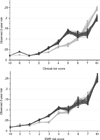Predicting 2-Year Risk of Developing Pneumonia in Older Adults without Dementia
- PMID: 27401847
- PMCID: PMC4943660
- DOI: 10.1111/jgs.14228
Predicting 2-Year Risk of Developing Pneumonia in Older Adults without Dementia
Abstract
Objectives: To develop three prognostic indices of varying degree of required detail for 2-year pneumonia risk in older adults.
Design: Retrospective cohort study.
Setting: Group Health (GH), an integrated healthcare delivery system.
Participants: Community-dwelling dementia-free individuals aged 65 and older who had been GH members for at least 2 years before start of follow-up and were enrolled in the Adult Changes in Thought study (N = 3,375; development cohort, n = 2,250; validation cohort, n = 1,125.
Measurements: Potential pneumonia risk factors were identified from questionnaire data and interviewer assessments of functional status, medical history, smoking and alcohol use, cognitive function, personal care, and problem solving. Risk factors were also identified based on physical measures such as grip strength and gait speed and administrative database information on comorbid illnesses, laboratory tests, and prescriptions dispensed. Incident community-acquired pneumonia was defined presumptively from administrative data and validated using medical record review.
Results: Participants (59% female) contributed 12,998 visits at which risk factors were assessed; 642 pneumonia events were observed during follow-up. Age, sex, chronic obstructive pulmonary disease, congestive heart failure, body mass index, and use of inhaled or oral corticosteroids were critical predictors in all prognostic indices. A risk score based on these seven variables, information on which is commonly available in electronic medical records (EMRs), had equal or better performance (c-index = 0.69 in the validation cohort) than scores including more-detailed data such as functional status.
Conclusion: Data commonly available in EMRs can stratify older adults into groups with varying subsequent 2-year pneumonia risk.
Keywords: aged 80 and older; pneumonia; predictive value of tests.
© 2016, Copyright the Authors Journal compilation © 2016, The American Geriatrics Society.
Figures


Comment in
-
Quality Indicators of Drug Use and Risk of Pneumonia in Older Adults without Dementia.J Am Geriatr Soc. 2017 Jun;65(6):1365. doi: 10.1111/jgs.14730. Epub 2017 Feb 7. J Am Geriatr Soc. 2017. PMID: 28170081 No abstract available.
-
Reply to: Quality Indicators of Drug Use and Risk of Pneumonia in Older Adults without Dementia.J Am Geriatr Soc. 2017 Jun;65(6):1365-1366. doi: 10.1111/jgs.14736. Epub 2017 Feb 7. J Am Geriatr Soc. 2017. PMID: 28170082 No abstract available.
Similar articles
-
Seasonality, risk factors and burden of community-acquired pneumonia in COPD patients: a population database study using linked health care records.Int J Chron Obstruct Pulmon Dis. 2017 Jan 17;12:313-322. doi: 10.2147/COPD.S121389. eCollection 2017. Int J Chron Obstruct Pulmon Dis. 2017. PMID: 28176888 Free PMC article.
-
Risk factors for community-acquired pneumonia in immunocompetent seniors.J Am Geriatr Soc. 2009 May;57(5):882-8. doi: 10.1111/j.1532-5415.2009.02223.x. Epub 2009 Apr 21. J Am Geriatr Soc. 2009. PMID: 19453307
-
Modifiable risk factors for pneumonia requiring hospitalization of community-dwelling older adults: the Health, Aging, and Body Composition Study.J Am Geriatr Soc. 2013 Jul;61(7):1111-8. doi: 10.1111/jgs.12325. Epub 2013 Jun 17. J Am Geriatr Soc. 2013. PMID: 23772872 Free PMC article.
-
Development and validation of a prognostic index for 4-year mortality in older adults.JAMA. 2006 Feb 15;295(7):801-8. doi: 10.1001/jama.295.7.801. JAMA. 2006. PMID: 16478903
-
Predictors of in-hospital mortality of older patients admitted for community-acquired pneumonia.Age Ageing. 2011 Nov;40(6):736-41. doi: 10.1093/ageing/afr087. Epub 2011 Jul 18. Age Ageing. 2011. PMID: 21771744
Cited by
-
Validation of discharge diagnosis codes to identify serious infections among middle age and older adults.BMJ Open. 2018 Jun 19;8(6):e020857. doi: 10.1136/bmjopen-2017-020857. BMJ Open. 2018. PMID: 29921683 Free PMC article.
-
Diagnostic value of symptoms and signs for identifying urinary tract infection in older adult outpatients: Systematic review and meta-analysis.J Infect. 2018 Nov;77(5):379-390. doi: 10.1016/j.jinf.2018.06.012. Epub 2018 Jun 30. J Infect. 2018. PMID: 29964141 Free PMC article.
-
Limited evidence for diagnosing bacterial skin infections in older adults in primary care: systematic review.BMC Geriatr. 2019 Feb 18;19(1):45. doi: 10.1186/s12877-019-1061-y. BMC Geriatr. 2019. PMID: 30777025 Free PMC article.
References
-
- Almirall J, Bolibar I, Vidal J, et al. Epidemiology of community-acquired pneumonia in adults: A population-based study. Eur Respir J. 2000;15:757–763. - PubMed
-
- Jokinen C, Heiskanen L, Juvonen H, et al. Incidence of community-acquired pneumonia in the population of four municipalities in eastern Finland. Am J Epidemiol. 1993;137:977–988. - PubMed
-
- Akram AR, Chalmers JD, Taylor JK, et al. An evaluation of clinical stability criteria to predict hospital course in community-acquired pneumonia. Clin Microbiol Infect. 2013;19:1174–1180. - PubMed
-
- Koivula I, Sten M, Makela PH. Prognosis after community-acquired pneumonia in the elderly: A population-based 12-year follow-up study. Arch Intern Med. 1999;159:1550–1555. - PubMed
Publication types
MeSH terms
Grants and funding
LinkOut - more resources
Full Text Sources
Other Literature Sources
Medical

